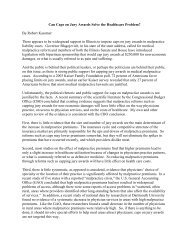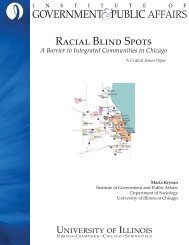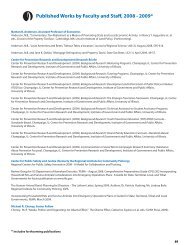The Illinois Report 2013 - Institute of Government & Public Affairs ...
The Illinois Report 2013 - Institute of Government & Public Affairs ...
The Illinois Report 2013 - Institute of Government & Public Affairs ...
Create successful ePaper yourself
Turn your PDF publications into a flip-book with our unique Google optimized e-Paper software.
C H A P T E R 2<br />
Figure 3<br />
<strong>Illinois</strong> Consolidated Funds Budget Gap<br />
Projections to FY 2023 with Medicaid Growth<br />
as Projected or Held to Consumer Price Index<br />
Inflation Rate<br />
Budget Gap, Billions <strong>of</strong> Nominal Dollars<br />
0<br />
-1<br />
-2<br />
-3<br />
-4<br />
-5<br />
-6<br />
-7<br />
-8<br />
-9<br />
-10<br />
2012<br />
Baseline - Projected Medicaid Growth<br />
Medicaid Growth Held to Inflation Rate<br />
<strong>2013</strong><br />
2014<br />
2015<br />
2016<br />
2017<br />
2018<br />
Fiscal Year<br />
2019<br />
2020<br />
2021<br />
2022<br />
2023<br />
Figure 4<br />
<strong>Illinois</strong> Medicaid Expenditures Projections<br />
to FY 2020: Historical Growth, Held to<br />
Consumer Price Index Inflation Rate, $1.6<br />
Billion Cut and Historical Growth<br />
Medicaid Expenditures, Billions <strong>of</strong> 2012 Dollars<br />
20<br />
19<br />
18<br />
17<br />
16<br />
15<br />
14<br />
13<br />
12<br />
2010<br />
2011<br />
Historical Growth<br />
1.6 Billion Cut <strong>2013</strong><br />
Hold to Inflation<br />
2012<br />
<strong>2013</strong><br />
2014<br />
2015<br />
2016<br />
Fiscal Year<br />
Source: IGPA Fiscal Futures Model, November 2012.<br />
2017<br />
2018<br />
2019<br />
2020<br />
Source: IGPA Fiscal Futures Model, November 2012.<br />
See notes to Figure 1.<br />
B. Medicaid Expansion under ACA<br />
FYs 2009-2011. 22 In FY 2012, as the federal stimulus<br />
ended, <strong>Illinois</strong> received $2.7 billion less in federal<br />
monies than it had received in FY 2011. To <strong>of</strong>fset this<br />
reduction, <strong>Illinois</strong> leaders enacted a plan <strong>of</strong> cost savings<br />
and cuts expected to save $1.6 billion in FY <strong>2013</strong>.<br />
If Medicaid growth continues at historical rates, the<br />
one-time cuts <strong>of</strong> $1.6 billion made in <strong>2013</strong> will hold<br />
spending below its inflation-adjusted 2012 level for<br />
about five years (Figure 4).<br />
<strong>The</strong> Affordable Care Act (ACA) will expand Medicaid<br />
to provide health coverage for those with incomes<br />
at 138 percent <strong>of</strong> the federal poverty level<br />
(FPL) and below. 23 Because the <strong>Illinois</strong> Medicaid program<br />
has historically provided broader coverage<br />
than many other states, analysts anticipate that the<br />
ACA will have less impact upon <strong>Illinois</strong>. For example,<br />
<strong>Illinois</strong> already covers patients up to 133 percent<br />
<strong>of</strong> the FPL. However, <strong>Illinois</strong> relies on federal funds<br />
22<br />
For Q1 and Q2 <strong>of</strong> Federal Fiscal Year (FFY) 2009 the match rate was increased to 60.48 percent; then increased to 61.88 percent Q3<br />
FFY 2009 thru Q1 FFY 2011; then dropped to 59.05 percent for Q2 FFY 2011, 57.16 percent for Q3 FFY 2011, 50.20 percent for Q4 FFY<br />
2011 and back to 50.0 percent in Q1 FFY 2012. <strong>The</strong> federal fiscal year begins October 1; the state fiscal year begins July 1. Q1 federal<br />
FY = Q2 state FY. See <strong>The</strong> Council <strong>of</strong> State <strong>Government</strong>s, “States Face Medicaid Match Loss After Recovery Act Expires.” March 2011,<br />
http://knowledgecenter.csg.org/drupal/system/files/States_Face_Medicaid_Match_Loss_After_Recovery_Act_Expires_0.pdf (Archived<br />
by WebCite ® at http://www.webcitation.org/6CdtSjxW9).<br />
23<br />
<strong>The</strong> ACA will expand Medicaid to cover individuals in households with incomes below 133 percent <strong>of</strong> the FPL. However, 5 percent <strong>of</strong><br />
income will be disregarded, which effectively raises the limit to 138 percent <strong>of</strong> the federal poverty level. See Kaiser Family Foundation,<br />
“Determining Income for Adults Applying for Medicaid and Exchange Coverage Subsidies: How Income Measured With a Prior Tax<br />
Return Compares to Current Income at Enrollment.” March 2011, http://www.kff.org/healthreform/upload/8168.pdf . (Archived by<br />
WebCite® at http://www.webcitation.org/6CxSUoHoM).<br />
20<br />
<strong>The</strong> <strong>Illinois</strong> <strong>Report</strong> <strong>2013</strong>














